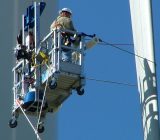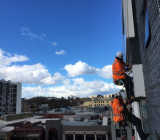Whether you work at height every day or just occasionally, working safely should always be your top priority. It only takes one error to turn a routine task into a serious injury or fatality. It is your job to ensure that your employees are protected each and every time they could be exposed to a potential fall or hazard,
What is Working at Height?
Working at height refers to any work where a person could potentially fall and injure themselves. A ladder, a roof’s edge, an opening on the floor, and even a loading dock can be considered working at height.
1. Work on the ground or on a solid construction
If you don’t have to work at heights , always look for another option. Working from the ground is always the safest option. Engineers should be looking for alternatives to working at heights during the design-phase of the project.
2 Inspect Your PPE
Great. You’ve got the equipment you need to ensure a protected work environment. That won’t matter if the systems are worn to the point that they fail. Harnesses and lanyards need to be inspected annually, if not more frequently, by a competent person (one with the knowledge to recognize the hazard AND the authority to correct it). However, PPE should be inspected by the user prior to every use. It’s important that anyone who might be using the devices understands what they’re looking for, what is acceptable or not, and the steps to take should there be an issue. A pre-use check doesn’t have to take a lot of time but needs to be thorough. This step could be the difference between life and death.
3. Use a fall-prevention device
If you have to work from a height, always put management in place if there is risk of a fall. A fall-prevention device is our most reccomend equipment as it willl prevent your workers from falling. Examples include scaffolding, railing & guardrails. Regardless of which type you use, once in place & installed they will keep you and your workers safer when working at heights.
4. Use a work-positioning system
When it is not possible to use a fall-prevention device, a work-positioning system is your next best option.A work positioning system uses equipment to allow a worker to carry out work at height whilst being supported in a full body harness to prevent a fall. These systems fall into administrative PPE categories in the control hierarchy.
5. Use a fall-arrest system
A fall-arrest system is only used when it is not possible to use either a fall-prevention device or a work-positioning system. A fall-arrest system may not prevent a fall, however it stops a person who has fallen and reduces the impact of the fall and can reduce injuries in a fall. Examples include industrial safety nets, catch platforms or harness-based fall- arrest harnesses used with lifelines or individual anchors.
If you use a fall arrest system, you must have emergency and rescue procedures in place and test them to ensure they are effective.




